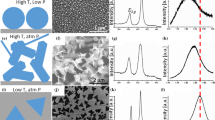Abstract
Transition metal dichalcogenides are 2D structures with remarkable electronic, chemical, optical and mechanical properties. Monolayer and crystal properties of these structures have been extensively investigated, but a detailed understanding of the properties of their few-layer structures are still missing. In this work we investigated the mechanical differences between monolayer and multilayer WSe2 and MoSe2, through fully atomistic molecular dynamics simulations (MD). It was observed that single layer WSe2/MoSe2 deposited on silicon substrates have larger friction coefficients than 2, 3 and 4 layered structures. For all considered cases it is always easier to peel off and/or to fracture MoSe2 structures. These results suggest that the interactions between first layer and substrate are stronger than interlayer interactions themselves. Similar findings have been reported for other nanomaterials and it has been speculated whether this is a universal-like behavior for 2D layered materials. We have also analyzed fracture patterns. Our results show that fracture is chirality dependent with crack propagation preferentially perpendicular to W(Mo)-Se bonds and faster for zig-zag-like defects.
Similar content being viewed by others
References
K. Bradley, J.-C. P. Gabriel, and G. Grüner, Nano Lett. 3, 1353 (2003).
G. Fiori, F. Bonaccorso, G. Iannaccone, T. Palacios, D. Neumaier, A. Seabaugh, S. K. Banerjee, and L. Colombo, Nature Nano. 9, 768 (2014).
F. Schwierz, Nature Nano. 5, 487 (2010).
Y. Sun and J. A. Rogers, Adv. Mater. 19, 1897 (2007).
P. Johari and V. B. Shenoy, ACS Nano 6, 5449 (2012).
F. Xia, H. Wang, D. Xiao, M. Dubey, and A. Ramasubramaniam, 8, 899 (2014).
K. F. Mak and J. Shan, Nature Photonics 10, 216 (2016).
D. Jariwala, V. K. Sangwan, L. J. Lauhon, T. J. Marks, and M. C. Hersam, ACS Nano 8, 1102 (2014).
Q. H. Wang, K. Kalantar-Zadeh, A. Kis, J. N. Coleman, and M. S. Strano, Nature Nano. 7, 699 (2012).
M. Chhowalla, H. S. Shin, G. Eda, L.-J. Li, K. P. Loh, and H. Zhang, Nature Chem. 5, 263 (2013).
W. S. Yun, S. W. Han, S. C. Hong, I. G. Kim, and J. D. Lee, Phys. Rev. B 85, 33305 (2012).
J.-K. Huang, J. Pu, C.-L. Hsu, M.-H. Chiu, Z.-Y. Juang, Y.-H. Chang, W.-H. Chang, Y. Iwasa, T. Takenobu, and L.-J. Li, ACS Nano 8, 923 (2014).
C. Huang, S. Wu, A. M. Sanchez, J. J. P. Peters, R. Beanland, J. S. Ross, P. Rivera, W. Yao, D. H. Cobden, and X. Xu, Nature Mater. 13, 1096 (2014).
Y. L. Huang, Z. Ding, W. Zhang, Y.-H. Chang, Y. Shi, L.-J. Li, Z. Song, Y. J. Zheng, D. Chi, S. Y. Quek, and A. T. S. Wee, Nano Lett. 16, 3682 (2016).
A. A. Mitioglu, P. Plochocka, Á. del Aguila, P. C. M. Christianen, G. Deligeorgis, S. Anghel, L. Kulyuk, and D. K. Maude, Nano Lett. 15, 4387 (2015).
M. Asadi, K. Kim, C. Liu, A. V. Addepalli, P. Abbasi, P. Yasaei, P. Phillips, A. Behranginia, J. M. Cerrato, R. Haasch, P. Zapol, B. Kumar, R. F. Klie, J. Abiade, L. A. Curtiss, and A. Salehi-Khojin, Science 353, 467 (2016).
S. Plimpton, J. Comput. Phys. 117, 1 (1995).
A. K. Rappe, C. J. Casewit, K. S. Colwell, W. A. Goddard, and W. M. Skiff, J. Am. Chem. Soc. 114, 10024 (1992).
J.-W. Jiang and Y.-P. Zhou, ArXiv:1704.03147 (2017).
W. Huang, H. Da, and G. Liang, J. Appl. Phys. 113, 104304 (2013).
S. Nosé, J. Chem. Phys. 81, 511 (1984).
W. G. Hoover, Phys. Rev. A 31, 1695 (1985).
S. Izrailev et al., in Lecture Notes in Computational Molecular Dynamics: Challenges, Methods, Ideas, edited by P. Deuflhard, J. Hermans, B. Leimkuhler, A. E. Mark, S. Reich, and R. D. Skeel (Springer-Verlag, Berlin, 1998).
P. Manimunda, Y. Nakanishi, Y. M. Jaques, S. Susarla, C. F. Woellner, S. Bhowmick, S. A. S. Asif, D. S. Galvao, C. S. Tiwary, and P. M. Ajayan, 2D Mater. 4, 45005 (2017).
Author information
Authors and Affiliations
Rights and permissions
About this article
Cite this article
Jaques, Y.M., Manimunda, P., Nakanishi, Y. et al. Differences in the Mechanical Properties of Monolayer and Multilayer WSe2/MoSe2. MRS Advances 3, 373–378 (2018). https://doi.org/10.1557/adv.2018.246
Published:
Issue Date:
DOI: https://doi.org/10.1557/adv.2018.246




